Permanent Makeup Pigments and Tattoo Ink
A week ago, I had a client inquire about what to do regarding an eyeliner that has turned different shades of blue. Normally, black with a drop of blue correction would help that situation but when I proposed the solution, she said she had already tried it and it was still bright blue. Then she told me that the previous technician had used tattoo ink on the client.
Being in both the Permanent Makeup and Tattoo industry, we know not to use tattoo ink for permanent makeup procedures, yet very little information state the actual reason. I’ve gone through many ink labels in my quest to find the difference between Tattoo Ink and Permanent Makeup Pigments, because we should get to the ingredient level of this.
In many courses, permanent makeup artists are taught that there are semi-permanent pigments and permanent pigments, which makes up the difference in tattoo and permanent makeup ink. I truly believed that. But I’ve yet to find a blog post or website that explains the actual differences in colorants (pigments). So I went on a little research expedition…
Permanent Makeup Pigment and Tattoo Ink Ingredients
Ingredients are what makes all the difference between tattoo ink and permanent makeup pigments. I remembered when I use to make cosmetics, I would research every particle and ingredient for compliance with Health Canada before making my lipstick or eyeshadow. In the cosmetic world, this is very important because FDA regulates particle size, pigments and carriers that can be use in cosmetic products. Since Permanent makeup pigments are under the same cosmetics banner, they also need to comply with the same regulations. So I did a bit of a comparison.
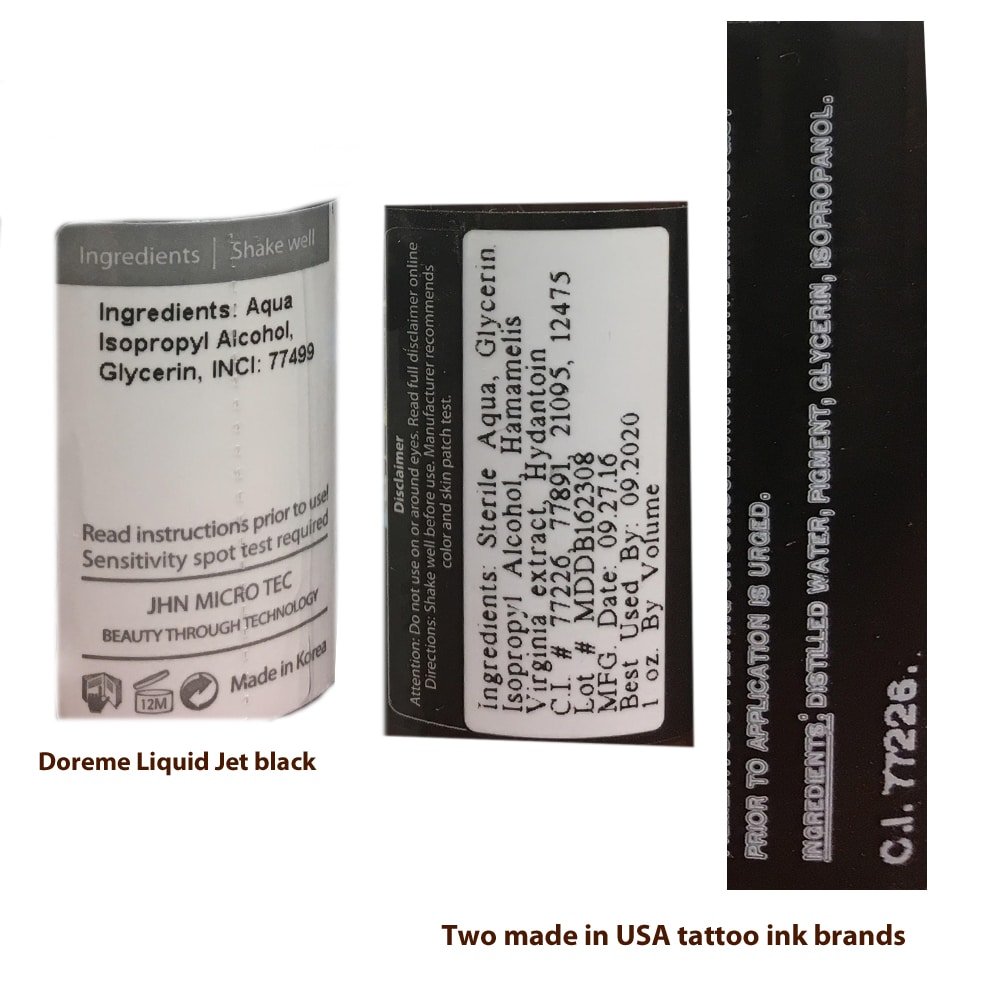 Black Colorants Comparison:
Black Colorants Comparison:
Tattoo Ink Black: CI 77226 (Pigment Black 7)
In my search on www.cosmeticinfo.org, this pigment is not listed for cosmetic use, which is fine, because this is a tattoo ink, not permanent makeup pigment.
Permanent Makeup Pigment: CI 77499 (Iron Oxide)
In my search on the same cosmeticinfo.org, this pigment is listed as iron oxide pigment along with other Iron Oxide CI numbers. For more information, please see: http://www.cosmeticsinfo.org/ingredient/iron-oxides
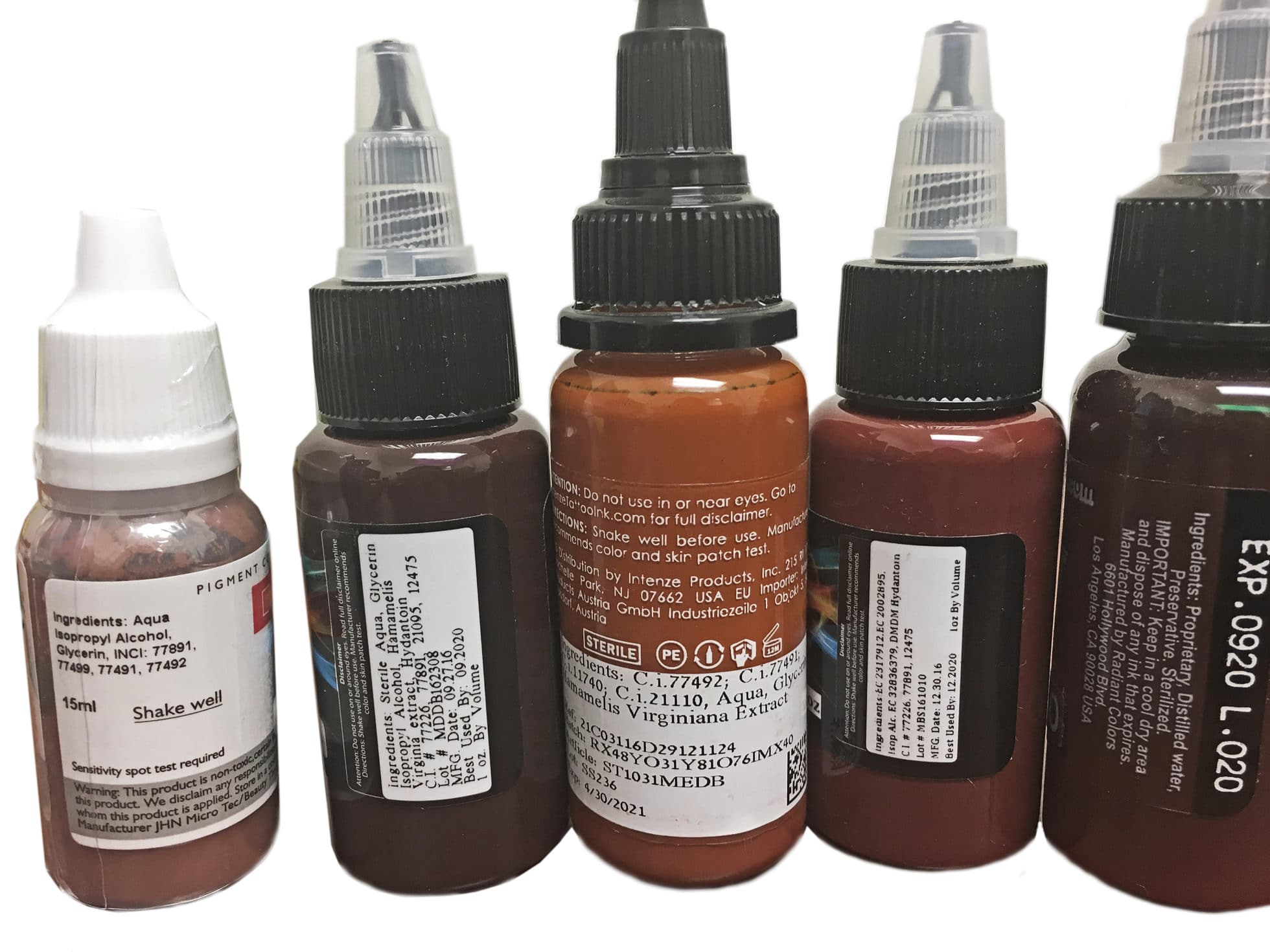 Brown Colorants Comparison:
Brown Colorants Comparison:
Tattoo and Permanent Makeup Ink Brown – Approved Cosmetic Pigments: CI 77491, 77492, 77891,
CI 77491, 77492 are both Iron Oxide pigments, same as CI 77499, and are also found in permanent makeup pigments. They are approved and commonly used for cosmetic products.
CI 77891 is Titanium dioxide, it is a natural mineral that is processed and purified for cosmetic products. For more information see: http://www.cosmeticsinfo.org/ingredient/titanium-dioxide
As the above pigments are in both tattoo and permanent makeup, below is where the differences appear:
Tattoo ink Brown, may also contain the following pigments:
CI 21095, 12475, 11740, 21110 and others ( I pulled out about four or five different browns from various brands, so there may be other ingredients in other brown colors in tattoo inks). Searching any of these CI numbers on Cosmetic Info, nothing pulls up, just like the CI 77226, however, on a quick google search, CI 21110 pulled up quite a few results, as an orange dye. And again, that is fine, since it is not for permanent makeup.
What I am pointing out from the above colorant research is that there are differences between body tattoo ink and permanent makeup pigments. Next, we are going to look at the carriers used such as Glycerin, Alcohol, Water, and Oils.
**Below are some pictures to show what it looks like on the Cosmetics Info website when an ingredient is listed and when one is not.**
Carriers
Going through the lot of tattoo inks and permanent makeup pigments, the carriers are mostly the same, such as:
- Aqua, Distilled water
- Isopropyl Alcohol
- Glycerin
The above carriers are all that are in our Doreme pigments.
However, there are items on the list that are different in various brands of tattoo inks:
- EC2317912
- EC2002895
- DMDM Hydantoin
- Preservatives (no other clarification)
- Witch Hazel / Hamamelis Virginiana Extract. (This is approved for cosmetics as a natural preservative either in either soluble or insoluble form.)
All the ingredients do not comply with regulation for cosmetic products, other than Witch Hazel. Preservatives may be, but it really depends on which. Ingredients need to be labeled clearly on cosmetic products. This is the case because the skin on our face is more sensitive and more prone to reactions. So when a cosmetic product does not tell you what exactly you are putting on your face, that is cause for concern.
Conclusion:
Cosmetics products, including Permanent Makeup Pigments’ ingredients are more regulated than tattoo ink and rightly so. Unfortunately, this did not answer which ingredient produced the bright blue in the eyeliner, but it did give us a reason on why it is not recommended to use tattoo ink for permanent makeup.



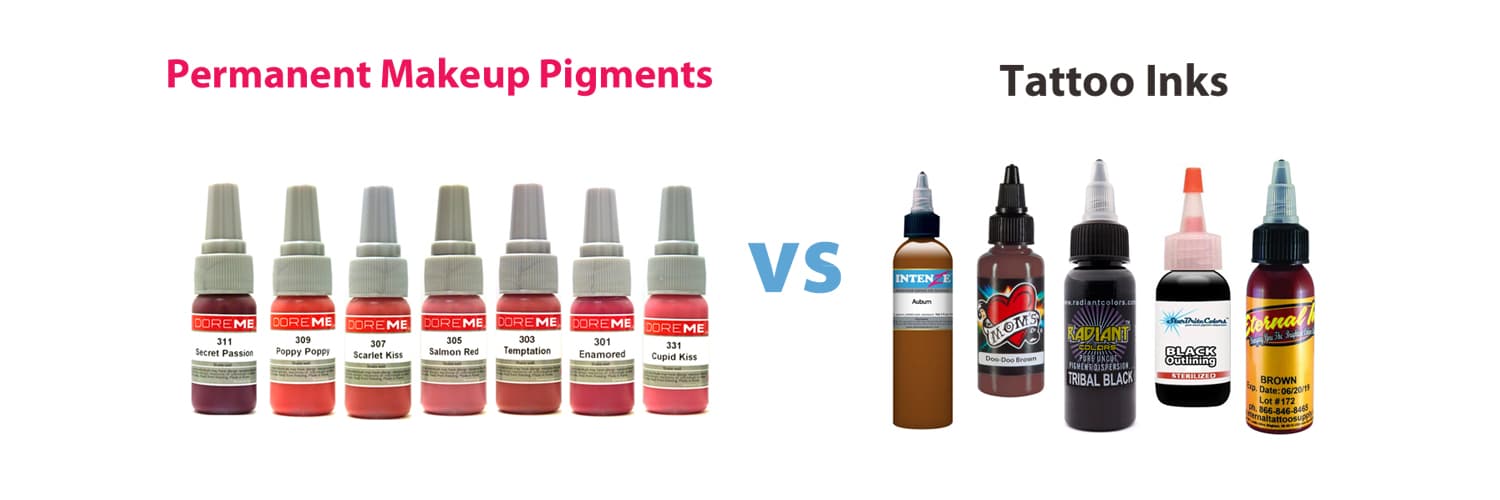


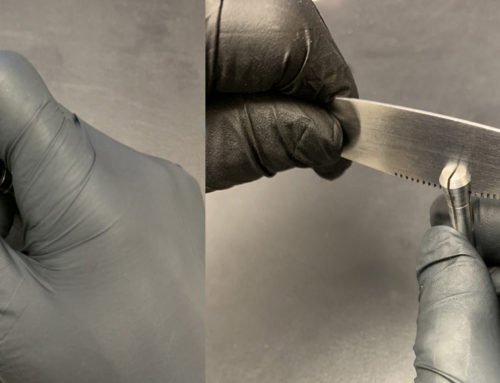


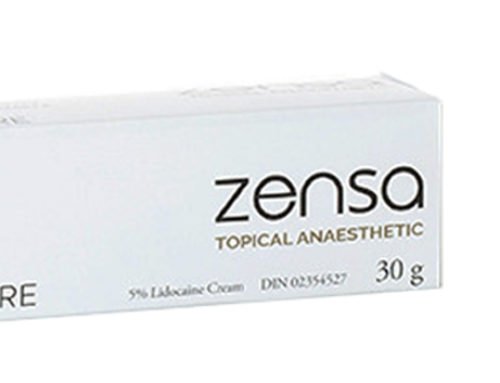
Very in depth and informative, excellent read. I have a question… I am trying to find a permanent make up line that is true to color when healed and will last more than six months! Please help. It looks as if all lines I’ve reviewed fade so much so fast.
Hello Dalia, our Doreme colors will heal true but pretty much all pigments will fade over time.
Thank you for doing the research however I am still not convinced that there are differences that give a reason NOT to use tattoo inks under certain circumstances. ALL pigments/inks will change colour under certain conditions and most permanent makeup colours do have correcting colours available for purchase alongside the pigments – which prove that they can change colour. The main thing is ink/pigment added to clients ethnicity = the final colour, it’s not just about the ink/pigment itself.
Hello Kay,
Thank you for your inquiry. The difference between ink and pigment is not only in the changing of colors, but also the migration of the pigment as well as the approval in each country’s pigment regulation. Its the same reason why you cannot use paint as makeup. The ingredients within are not deemed safe for cosmetics used. It has not only to do with the chemicals but particle emulsion stability and PH ratings of the liquid as well.
Permanent Makeup colors do have correcting colors, that is correct, but if you can use a pigment that does not require as much correcting, that will also help each procedure. When i use Doreme on my clients, i dont require the correcting colors, because i know what to use for what type of clients and i know the stability of the pigments, no matter what ethnicity.
So at the end of the day, the post is to tell artists to choose their pigment wisely. Do not use pigments that are not approved for cosmetic use. This is not only to protect your own business, but also to protect your clients as well. Artists that choose to use Tattoo Ink instead are doing so at their own risk.
Thank you
Great info,
Can you tell me if I k vs permanent makeup Ink is safer for tattooing areola a from mastectomies? I wails like to explain the difference as which one is safer for thier body, especially since there bodies are already immune compromised.
Hello Sandra, many people do use permanent makeup pigments for tattooing areola after mastectomies, as a matter of fact, our Doreme brand has pigments specifically designed for areola pigmentation. Regarding immune issues, I would recommend speaking with your doctor on his/her opinion on how long after the mastectomy would it be safe to undergo such a procedure.
I specialize in tattooing mastectomies, both art and nipples/ areolas. Ive seen the cosmetic inks fade dramatically over time so they have to be redone. I personally use permanent tattoo inks and have for years. I customize all of my colors according to the client and give them that 3D effect, not a solid color. It is not the same tissue as the face and mucus membrane areas, so you are safe with tattoo inks, providing you are using top quality inks and not purchasing off ebay, craigslist, or amazon. Rule of thumb is 6 months heal time for tattoo over last surgery of a mastectomy and depending on severity of scarring could be less or more. If scarring is bad, there are alternatives to reducing them beforehand also.
I was just wondering i wanted to get freckled tattoos but because it’s considered a cosmetic procedure most aestheticians use semi permanent inks the downfall it fades so quickly so do you know of any permanent ink I could purchase and mix preferably a dark brown/ ginger colour is what I’m going for?
What do you think about perma blend ? They say it’s between ink and pigment and that’s why it stays so long in the skin ?
I just purchased perma blend and I’m a bit worried !
Thank you !
Honestly I am not familiar with Perma Blend Tanya, wish I could help with that one!
Hi Tanya i did too and i am worry eyesterday i did a lips and look so dry i am not sure ehat going to happen. Did you had any problem with perm blend?
Hi I would like ask about pigments for PMU,I need to.know what is ingredients of this pigments. Thanks
It depends on which pigment as each one has different pigment colors. However, the base is Water, Isopropyl alcohol, glycerin and Surfectant (Surfactants are compounds that lower the surface tension (or interfacial tension) between two liquids, between a gas and a liquid, or between a liquid and a solid. Surfactants may act as detergents, wetting agents, emulsifiers, foaming agents, and dispersants.)
Honestly, I personally don’t feel there is a real reason NOT to use tattoo ink. I think, cosmetic ink is merely less likely to cause reactions on sensitive skin. Certain pigments can cause reactions but ink in general will do this whether on your face or body.
You’re comparing ink for tattoos vs cosmetic ink but the ink in general is a cosmetic thing whether it’s used on your body or not. Similar to how body lotions, soaps etc are within cosmetics. Tattoo ink uses ingredients that can be put in the skin by the FDA standards, skin is skin. Facial skin is thinner and may have more nerves but it’s still skin.
I think the reason a few aren’t being brought up in search is because site is referring to ingredients that can go ON the skin not within.
Then consider the fact that the US and even Canada plus other countries don’t really regulate cosmetics so “cosmetic ink” most the time is just a label.
Another comment mentioned tattoo ink as fine because of color correcting shades because your post begins with a person who has discolored brows which you imply is because of tattoo ink but this happens with “cosmetic ink” as well
Where are you getting the pigment numbers in different brands of tattoo inks?
Hello Ariel, I believe you are referring to the CI numbers, which are numbers given to substances to classify them. For example Carbon black is known as C.I. 77266. All brands of tattoo inks and permanent makeup pigments are comprised of varying pigments that are identified by their CI number in the ingredients list.
LIABILITY! That is the difference, your insurance company wont cover it. The ink manufacturer wont help you either if there is a problem because they dont have profuct liability insurance for their ink to be used on faces. terry Lively explains this very well on the Permablend facebook site.
Helen hit the nail on the head… Whether we can or should is not the issue. It’s absolutely a liability issue. Terry Lively’s video is very informative
After embroidery, especially eyebrow embroidery, it’s very obvious to see the ink turns to either red or green. So, we must be very cautious about the ingredients used in the pigment. Choose one without iron oxides!
I would love to get my eyebrows filled in and, I ended up here, wondering the difference between standard and cosmetic tattoos. Conventional tattoos last forel life and fade very little, while I often hear that cosmetic tattoos are temporary and the colors aren’t always true. The next concern is that these temporary cosmetic tattoo seem to cost more than conventional permanent tattoos. Ultimately, what is the benefit to a cosmetic tattoo, over a skilled and trusted tattoo artist?
Great questions to a well researched article.
My advice:
Always, always research the artist’s portfolio. Tattooed or microblading. Research before and after pictures/how the brows look like right after the procedure (pay attention to shaping of the brow, super important because you want a brow anatomically correct and balanced with face/bone structure), and how they look years later. Are the colors natural? Do they fade to red or purple? Look for reviews and what clients are saying.
You can have an incredibly talented tattoo artist do your brows and they are not played correctly or the pigment is too dark. You can have a cosmetic tattoo artist do your brows (who knows more about brow shaping) and use a method that gives a more feathery or bushy, natural appearance.
-Michelle
@microbladetampa (Instagram)
Microbladetampa.com
Hi there,
I have been using Doreme pigments, I love the color blends so well. The only problem I have is seeing the colour after I finished. It’s very light sometimes next to nothing. Any tips on how to make the colour more stronger on skin?
Hello Cici, this may be due to the pigment not being deposited deep enough into the dermal layer of the skin. I would suggest going deeper with the needle depth while being careful to not cause unnecessary damage to the skin. It is a matter of balance to go deep with better retention but risk of more damage to skin or light with less retention but less risk but more touch up.
Looking for best tattoo pigments and best machines
Hello Joseph, we carry Doreme Pigments and Perma Blend pigments, 2 of the top pigments in the industry that heal true, vibrant and consistent. If you are interested in machines, I would invite you to checkout our Artemis, Javelin and Minerva. The Artemis and Javelin are capable of using all standard size tattoo needle cartridges which allow for over 60+ needle configurations. Our Minerva is very popular among permanent makeup schools, it is easy to use, learn with and teach with.
Hi, I was wondering if your pigment inks can be used as tattoo inks ( non cosmetic ) as I really love the skin tone shades that you have available and these would be great to work with.
Thanks
Yes it can be used for body tattoo and it is common for permanent makeup pigments to be used for scar/areola.
Good article.. In Europe regulations are tightening on the products that you can use in permanent cosmetics. Some of the well-known brands may have to change their ingredients to become CTL registered. An easy way to tell if your cosmetic colours are pure pigment or an ink blend is to see if it stains when you put it onto skin like the back of your hand. Pure pigment will wipe off easily, blended pigment will be difficult to remove due to the ink (dye) content. Cosmetic pigments are more expensive but more stable with much less colour shift as they fade, especially if they are inorganic.
Great article! Would you mind if I used this in my pigment training ink v pigment?
Yes sure Lisa, just remember to link back to us!
So a large factor not addressed in migration is the micron count of ink vs. pigment….with the micron count being much smaller in ink it allows the lymphatic system to pick it up and migrate it more. This is especially true for the face as the system is closest to the skin in this area. As for “true black” to quickly sum up many factors you have to understand that there is no such thing in ink and pigments as blacks are typically made with a blue base, this and of course the filtering of skin tone over this will eventually turn blue (some have a green base, mainly older inks). Now higher quality ones will stay true longer, pigments are tough to find ones that will stay black through the fading process but hopefully as the industry grows there will be more quality pigments made. This is just a quick little summary of the reasons behind a couple of these issues, my suggestion is go and research. I am a pretty big nerd with degrees in art, a tattooist, and a permanent cosmetic artist. I research all before I do as there is so much false info out there and in a lot of cases the blind leading the blind recommending and doing things but not knowing why or even the reasoning behind it, even in my own training i asked questions that could not be answered by my teachers…..not what you want as a student.
….sorry, true black ink does exist but in the form of ink such as India ink….which if you are trying to use that then you have a whole set of other issues and should probably not be practicing lol
Great content and examples about the difference in permanent makeup pigment and tattoo ink. Many people I come across do not know the difference and thats why they think your eyebrows will turn blue over time lol. I created a permanent makeup informational website that provides clients for qualified local professionals in Hawaii that could be a good fit here. Is it ok if I post my site here and link to your blog?
I just had my eyeliner done for “touch-up” second session with the softap technique and it’s still gray. I expected more from the color. Is that normal for it to be gray and already faded 10 days after the procedure? Should I except that it was kind of a failure and walk away or would you recommend that I go in for a 3rd session?
That does not sound normal, the eyeliner should stay longer than 10 days.
Looking for pihment to have a nature lip color. What is your recommendation?
Thanks
Hello Ty, that would depend on what your natural lip color is. While it is a crude method, I would suggest you take a picture of your lips in good lighting and match it to the different pigment colors on our website. Note that screen differences in color may vary.
Can cosmetic/permanent makeup ink be used to hide a wrinkle or crease – For example – a horizonal line across the top of the nose? Can this line be filled in with skin-tone ink to make it less harsh?
It is possible but would have to be done by an experienced professional. The flesh tone ink would have to blend and match very well with the surrounding skin tone or the result may be worse than the original.
Hi,
There are 2 different kinds of pigments, organic and inorganic. Organic pigments contain carbon & hydrogen and provide more coverage and often have bold, vivid colors. These are what are used in regular body tattoos. Inorganic pigments contain iron and metal oxides and are duller, earthy tones. They are not as bold as organic pigments. These are the kinds that fade more easily and are used for permanent makeup.
If you are looking at the CI numbers, organic pigments are numbers 11000-74999, and inorganic pigments are numbers 77000-77999. A lot of PMU brands use both organic and inorganic pigments, so they will last longer, like permablend. It’s a good indicator that you need to be extra careful because what you do will stick! Other brands like LI Aqua are all inorganic pigments so they are very safe to use because they will be more forgiving, but you will have to do a lot of passes to get the color intensity you want.
You are awesome
The organic colorants listed in this article as “Tattoo Brown Pigments” (CI 21095, 12475, 11740, 21110, 77226) are all present in Permablend/Tina Davies pigments. Examples are: TD Medium Brown, TD Blonde, PB Taupe, PB Fudge, PB Fores Brown, TD Ebony, PB Burnt Sienna.
Permablend and Tina Davies pigments have little to no inorganic colorants.
Also, CI 77226 is Carbon Black or Black 6 (not Black 7, as stated in this article).
As somebody who works in the tattoo industry and also creates tattoo inks this is one of the most misinformed articles I have read in a long time. I know many high profile professional artist that will always use tattoo ink over permanent make up ink. When it comes to the chemistry of ink if it comes from the same manufacturer usually the chemical formula is going to be the same except for the pigment load and the thickness. Comparing pigment and ink from different manufactures is no gauge on whether or not you should or shouldn’t use tattoo ink for permanent make up.
One thing that’s very apparent in the industry is that permanent makeup ink is highly “pink taxed”. You especially see this with Brow daddy products and Tina Davies products as you’re paying for $.50 worth of ink and $40 worth of packaging.
As for regulation it is virtually the same as ink & pigment are deposited in the skin very much the same.
Pigments generally have a lot more variety when it comes to brow and lip colours but other than that there’s almost no difference between the two so I find your research a little troubling in misleading